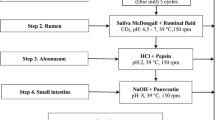Abstract
The biological control of helminth parasites of bovines by nematophagous fungi is an alternative to the use of drugs with the principal objective of reducing the source of infection available on pastureland. The maintenance of predatory activity of the fungal isolates is one of the basic prerequisites to ensure the success of this form of control. In this study behaviour of the isolates I31 of Arthrobotrys robusta and NF34a of Monacrosporium thaumasium was investigated following three storage methods: stored at 4 °C, cryopreserved with or without cryoprotectants or preserved in silica gel. All samples were subsequently passed through the gastrointestinal tract of calves. The latter involved the administration of 20 g of mycelia to the animals. This quantity was sufficient to recover fungal material from the faeces. The peak reduction in the number of infective larvae in the faeces occurred 24 h after administration of the samples (P < 0.05). The storage at 4 °C was the treatment that produced the greatest reduction in larvae for NF34a (81.3%) and I31 (65.1%) isolates. Nf34a isolate was responsible for the highest percentage reduction of larval helminth populations (P < 0.05). Cryopreservation appears to be an efficient method of preserving isolates, although diminished predatory capacity compared to storage at 4 °C was seen only for isolate NF34a (73.2%). Cryopreservation did not interfere in predatory activity of I31 isolate (P < 0.05). Maintenance of isolates in silica gel showed the lowest reduction throughout the experiment (P < 0.05).
Similar content being viewed by others
References
AraÚjo, J.V., Gomes, A.P.S. & Guimarães, M.P. 1998 Biological control of bovine gastrointestinal nematode parasites in southern Brazil by the nematode-trapping fungus Arthrobotrys robusta. Revista Brasileira de Parasitologia Veterinária 7, 117–122.
AraÚjo, J.V., Campos, A.K., Paiva, F. & Vieira-Bressan, M.C.R. 2001 Antagonistic effect of nematode-trapping fungi Arthrobotrys on infective larvae of Oesophagostomum radiatum, Cooperia punctata and Haemonchus placei. Revista Brasileira de Ciências Veterinárias 8, 81–84.
AraÚjo, J.V., Stephano, M.A. & Sampaio, W.M. 1999 Passage of nematode-trapping fungi through the gastrointestinal tract of calves. Veterinarski Arhiv 2, 69–78.
Dingrha, O.D. & Sinclair, J.B. 1995 Basic Plant Pathology Methods. CRC Press: Boca Raton. ISBN: 0-873-71638-8.
Faedo, M., Larsen, M. & Waller, J.P. 1997 The potential of nematophagous fungi to control free-living stages of nematodes parasites of sheep, comparison between Australian isolates of Arthrobotrys spp. and Duddingtonia flagrans. Veterinary Parasitology 72, 149–155.
Grønvold, J., Wolstrup, J., Nansen, P. & Henriksen, S.A. 1993 Nematode-trapping fungi against parasitic cattle nematodes. Parasitology Today 9, 137–140.
Guimarães, M.P. 1971 Variação sazonal de larvas infectantes de nematãides parasitos de bovinos em pastagens do cerrado de Sete Lagoas, Minas Gerais. Master thesis. ICB-UFMG, Belo Horizonte, Brasil.
Holden, A.N.G. & Smith, D. 1992 Effects of cryopreservation methods in liquid nitrogen on viability of Puccina abrupta var. partheniicola urediniospores. Mycological Research 96, 473–476.
Larsen, M. 1999 Biological control of helminths. International Journal for Parasitology 29, 139–146.
Larsen, M., Faedo, M., Waller, P.J. & Hennessy, D.R. 1998 The potential of nematophagous fungi to control the free-living stages of nematode parasites of sheep, studies with Duddingtonia flagrans. Veterinary Parasitology 76, 121–128.
Roberts, F.H.S. & O'Sullivan, J.P. 1950 Method for egg counts and larval cultures for strongyles infesting the gastrointestinal tract of cattle. Australian Journal of Agriculture Research 1, 99–102.
Ryan, M.J., Smith, D. & Jeffries, P. 2000 A decision-based key to determine the most appropriate protocol for the preservation of fungi. World Journal of Microbiology and Biotechnology 16, 183–186.
Sharma, B. & Smith, D. 1999 Recovery of fungi after storage for over a quarter of a century. World Journal of Microbiology and Biotechnology 15, 517–519.
Smith, D. & Onions, A.H.S. 1994 The Preservation and Maintenance of Living Fungi. CAB International: Wallingford. ISBN: 0-851-98902-0.
Smith, D. & Thomas, V.E. 1998 Cryogenic light microscopy and the development of cooling protocols for the cryopreservation of filamentous fungi. World Journal of Microbiology and Biotechnology 14, 49–57.
Waller, P.J. 1999 International approaches to the concept of integrated control of nematode parasites of livestock. International Journal for Parasitology 29, 155–164.
Waller, P.J. & Faedo, M. 1996 The prospect for biological control of the free-living stages of nematode parasite of livestock. International Journal for Parasitology 26, 915–925.
Wolstrup, J., Grønvold, J., Henriksen, S.A., Nansen, P., Larsen, M., Bøgh, O. & Iløe, B. 1994 An attempt to implement the nematodedestroying fungus Duddingtonia flagrans in biological control of trichostrongyle infections of first grazing calves. Journal of Helminthology 68, 175–180.
Author information
Authors and Affiliations
Rights and permissions
About this article
Cite this article
Mota, M.A., Campos, A.K. & Araújo, J.V. Influence of different storage methods on the predatory capacity of the fungi Arthrobotrys robusta and Monacrosporium thaumasium after passage through the bovine gastrointestinal tract. World Journal of Microbiology and Biotechnology 19, 913–916 (2003). https://doi.org/10.1023/B:WIBI.0000007314.76357.00
Issue Date:
DOI: https://doi.org/10.1023/B:WIBI.0000007314.76357.00




